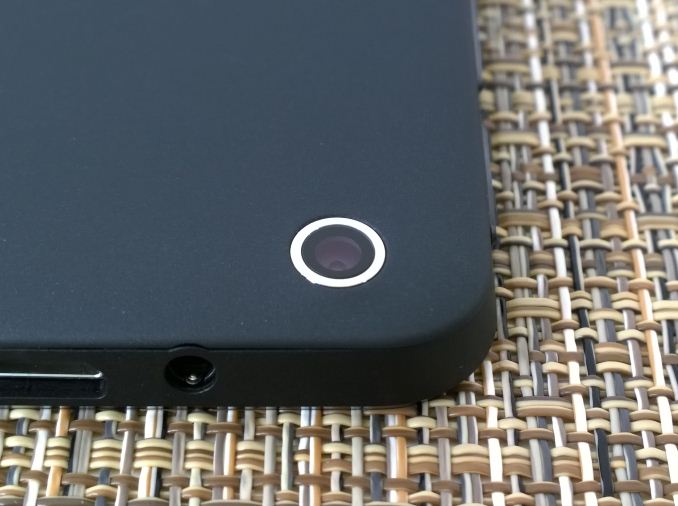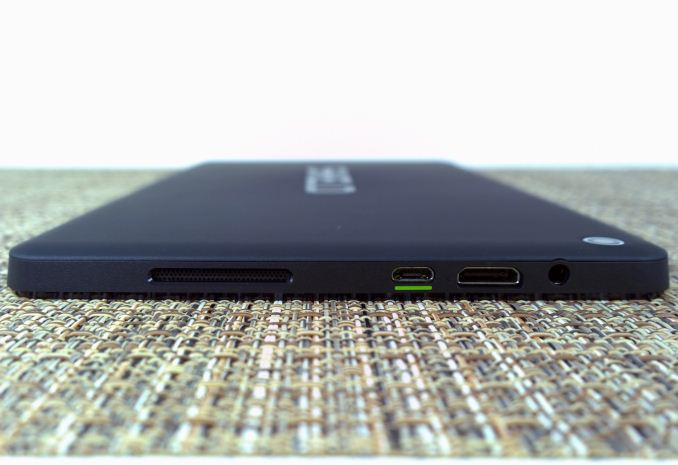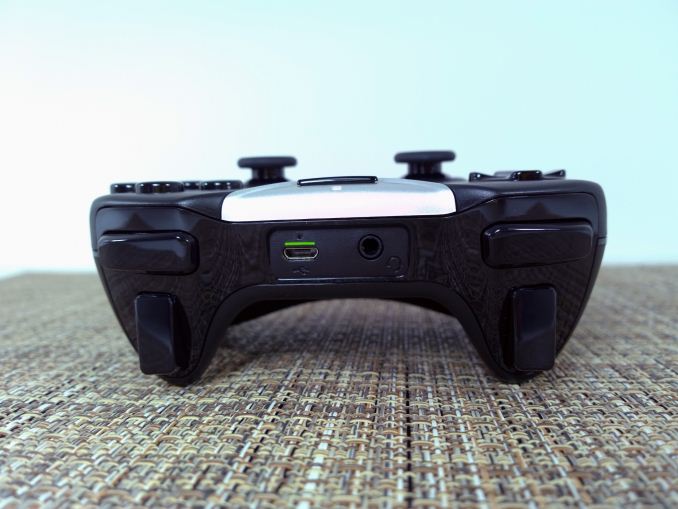The NVIDIA SHIELD Tablet Review
by Joshua Ho on July 29, 2014 9:00 AM ESTFinal Words
If I’m honest, it’s hard for me to review tablets. While I academically understand why people like tablets, I’ve never really found a use for them. They’re less comfortable to use in bed than a phone, I usually can’t type on a tablet as quickly as I do on a phone due to the size and weight, and in general it’s hard to justify a tablet when a phone is generally much more versatile. So when I got the Shield Tablet, I didn’t really know what to expect. While I have a Shield Portable, I don’t spend much time gaming on it, especially when I have a desktop that can do it much better. I came away from my experience pleasantly surprised.
Over the past five days, I’ve learned a lot about this device. As a tablet, it’s good. The material design and industrial design is acceptable and the device itself is quite ergonomic but it doesn’t blow me away. However, given the need to meet cost constraints, the matte plastic feel is really all that’s necessary and I don’t have any complaints in this area.
In the other fundamentals, we see a bit of a checkered pattern. In the display, the static contrast is quite high, and the calibration is good, but the gamut of the display doesn’t cover sRGB. This would definitely be an area that should be improved for the next generation. Although there are some compelling reasons to go with smaller color gamut, it ends up as a disadvantage when compared to other general-purpose tablets. The display is still perfectly usable, but it's a bit more washed out than I'd like.
In battery life, we see that the Shield Tablet ends up doing relatively well in web browsing, but for intensive gaming the tablet can’t spend much time away from an outlet before draining the battery completely. This is likely to be an unavoidable tradeoff, given the immense amounts of performance that Tegra K1 provides versus the power costs of doing so on a 28nm process. Anyone that has lived with a gaming laptop should understand this. As said before, it’s also possible to improve battery life from the 2.5 hour figure if the game is light enough to allow the GPU to run at lower frequencies. Barring that, NVIDIA has included options to cap the maximum frame rate of the display and reduce maximum CPU frequencies.
Otherwise the only other notable difficulty I’ve run into is with the stylus. Generally speaking it works well enough, but the stylus requires a bit more lift between words than I’m used to and keeping it from feeling fully natural. But I will be the first to admit that this is a minor issue at best.
Outside of the tablet itself, the gaming features are compelling. The larger 8” display and massively improved SoC on the Shield Tablet made for a far better gaming experience than what I had on Shield Portable. There’s a great deal of potential in ShadowPlay on a tablet, as while screen recording is nothing new in PCs this feature is often difficult to enable on Android. This is before we talk about the effects that live video encoding has on UI performance. ShadowPlay has managed to enable easy screen recording on a mobile device and do so without significantly impacting performance.
Meanwhile GameStream and GRID are even better on the larger screen that the tablet provides. While it was cool to play PC games on the Shield Portable, the size of the display simply made some elements too small to reasonably see. Now, there are no such issues. GameStream and GRID are definitely a lot of fun to use, especially if the game is well-adapted to playing on a controller.
Ultimately though, I feel that the native game library is the most important aspect of this device. While there are plenty of solid single player games, multiplayer games are few and far between. I still feel that multiplayer is where Shield has the strongest potential because it makes the difference between tens of hours per game and hundreds, even thousands of hours per game. There are definitely signs that this aspect of the ecosystem will improve in the near future as Trine 2 supports local multiplayer and War Thunder on Shield Tablet should be able to play online against console and PC players.
After getting through all of these observations over the past five days, I’ve come to realize that even though it’s not the perfect tablet, all of the features that this device brings to the table right now would be enough for me to seriously consider buying one. If NVIDIA manages to get enough multiplayer titles with an active community on Shield Tablet, there wouldn’t be a need to stop and consider at all. As someone that has spent the past few years never considering a tablet purchase at all, the Shield Tablet is the first ARM tablet that I would seriously think about buying.
The SHIELD Tablet is 299 USD for the 16GB WiFi model, 399 USD for the 32 GB LTE model. Each controller is 59.99 USD and the cover is 39.99 USD. While the 16GB model is 70 dollars more expensive than the Nexus 7 equivalent, the gap narrows to 50 dollars for the 32GB LTE model. Given the sheer amount of utility that this device brings to the table, the pricing is definitely set at the right place.














174 Comments
View All Comments
TheJian - Wednesday, July 30, 2014 - link
Full 3.1 ES support and OpenGL 4.4. Being based on desktop gpus it should become a very good emu platform over time. I wonder if a 20nm M1 would be totally able to play wiiu games too? I find myself wanting to hold out for a 20nm version of NV's chip for a serious boost in power for gaming since android seems to be really taking off in this area. I couldn't justify a tablet before just as a tablet, but my list of android games I want to play is growing so might have to bite soon. Dad's nexus 10 isn't good enough for many things (dang res being too high). I hope NV sticks with 1080p/1200p for a while so gaming just gets better not slower on android. Above this is just stupid in something under 13in with gaming as an intention.Another review showed it running emus and Zelda Ocarina of time.
http://gizmodo.com/nvidia-shield-tablet-review-a-g...
Mupen64. Dolphin guys will probably adapt it to K1 soon I'd guess. The power and features are there. N64 games work at least according to gizmodo guy. I'm not really interested in anything before n64's time but there's some pretty fun stuff on n64 or better I wouldn't mind playing today (never owning any nintendo product previously).
Knowname - Wednesday, July 30, 2014 - link
the controller is certainly as uncomfortable as an n64's *bazinga*NZtechfreak - Monday, August 18, 2014 - link
Dolphin will run, on time trial mode (no other racers onscreen) in Double Dash it gets 40-60fps, with high 40 to high 50s the majority of the time. Haven't yet tried a lot of other stuff. The Dolphin developers are really looking forward to the 64-bit K1.bossmoogle - Tuesday, July 29, 2014 - link
I'm considering one of these but for me an important factor that wasn't discussed in the review was the glass on the display. I'm guessing it's not GorillaGlass. Is it scratch resistant at all? I'm on a Nexus 7 2013 right now and the GOrillaGlass is just amazing, if I wipe my screen off it still looks pristine as if it had just gotten off the assembly line. Not a single micro scratch is visible in the sunlight. Once you've used something like that it's very hard to go back to a screen you know is going to get all scratched up.schizoide - Tuesday, July 29, 2014 - link
The nexus7 2013 actually uses Corning's "Fit" or "Concore" glass, which is not as scratch resistant as corning gorilla glass.I researched it briefly but was unable to find what the shield tablet uses. So I agree that it's probably not gorilla glass, or they would have said so.
kron123456789 - Tuesday, July 29, 2014 - link
Good thing about games on this tablet is that Tegra K1 optimized games are using desktop OpenGL, not mobile OpenGL ES.kidconcept - Tuesday, July 29, 2014 - link
> Of course, the real question here is whether the gaming side is worth the price premium.Can you mention some other tablets the Shield has to compete with on price? For example, the Nexus 7 costs about $60 dollars more than the Shield (16GB +$70, 32GB-LTE +$50). Anything else in the same class as the Shield that is significantly cheaper?
Great review BTW. Hit all the important points for most of the audience. As an artist, I'm curious about how the stylus performs, but I recognize that nobody else really cares about it.
schizoide - Tuesday, July 29, 2014 - link
You've got that backwards. The Nexus 7 16GB retails for $230 and the Nexus 7 32GB model with LTE at $350.The nvidia shield tablet 16GB retails for $300, and the 32GB model with LTE will sell for $400.
schizoide - Tuesday, July 29, 2014 - link
Also like I posted earlier, if you're OK with manufacturer refurbs, you can pick up a N7 16GB refurb from an authorized reseller for $140 on eBay. Half the price.kidconcept - Tuesday, July 29, 2014 - link
Refurbs isn't really a great price comparison.